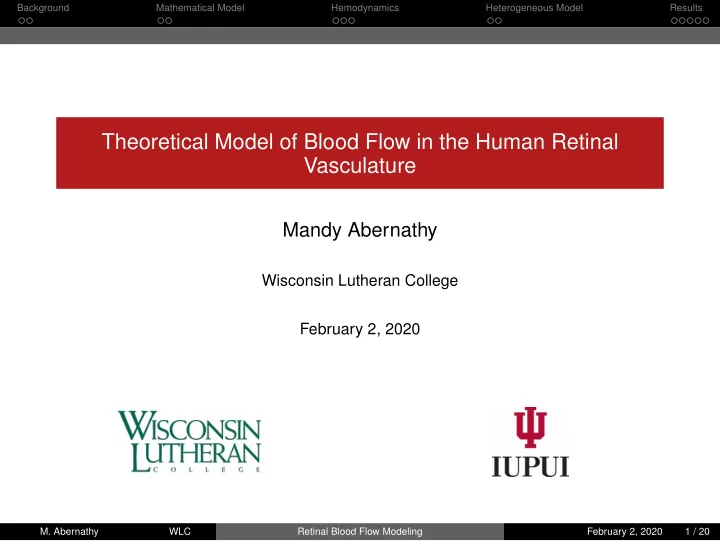

Background Mathematical Model Hemodynamics Heterogeneous Model Results Theoretical Model of Blood Flow in the Human Retinal Vasculature Mandy Abernathy Wisconsin Lutheran College February 2, 2020 M. Abernathy WLC Retinal Blood Flow Modeling February 2, 2020 1 / 20
Background Mathematical Model Hemodynamics Heterogeneous Model Results Background M. Abernathy WLC Retinal Blood Flow Modeling February 2, 2020 2 / 20
Background Mathematical Model Hemodynamics Heterogeneous Model Results Background Biological Background Glaucoma is a serious ocular disease that results in irreversible vision loss Increased intraocular pressure damages the optic nerve Almost one third of glaucoma patients do not exhibit elevated pressures There are other factors that cause continuing damage Source: Murata Eyecare Optometry M. Abernathy WLC Retinal Blood Flow Modeling February 2, 2020 3 / 20
Background Mathematical Model Hemodynamics Heterogeneous Model Results Background Biological Motivation Possible correlation between impaired blood flow and glaucoma-related damage Impaired oxygenation could be a cause or an effect of retinal ganglion cell death and loss of retinal function Source: Concepts of Biology M. Abernathy WLC Retinal Blood Flow Modeling February 2, 2020 4 / 20
Background Mathematical Model Hemodynamics Heterogeneous Model Results Mathematical Model M. Abernathy WLC Retinal Blood Flow Modeling February 2, 2020 5 / 20
Background Mathematical Model Hemodynamics Heterogeneous Model Results Mathematical Models Heterogeneous Model Provides more accurate depiction of oxygen delivery A previous heterogeneous model predicts retinal oxygenation in the mouse Differences between mouse and man: vessel size four arterial branches vs. six fovea Figure: Arteriolar Network in the Mouse Retina M. Abernathy WLC Retinal Blood Flow Modeling February 2, 2020 6 / 20
Background Mathematical Model Hemodynamics Heterogeneous Model Results Mathematical Models Research Goals Objective To develop a theoretical model of the human retinal arterioles based on oximetry data to predict retinal blood and tissue oxygenation M. Abernathy WLC Retinal Blood Flow Modeling February 2, 2020 7 / 20
Background Mathematical Model Hemodynamics Heterogeneous Model Results Hemodynamics M. Abernathy WLC Retinal Blood Flow Modeling February 2, 2020 8 / 20
Background Mathematical Model Hemodynamics Heterogeneous Model Results Hemodynamics Blood Flow Poiseuille’s Law Q = π (∆ P ) D 4 128 L µ M. Abernathy WLC Retinal Blood Flow Modeling February 2, 2020 9 / 20
Background Mathematical Model Hemodynamics Heterogeneous Model Results Hemodynamics Oxygen Transport - Green’s Function Model Source: Secomb et al. 2004 This more realistic model of oxygen transport accounts for the diffusion of oxygen from multiple blood vessels Vessel points are considered oxygen sources and tissue points are considered oxygen sinks M. Abernathy WLC Retinal Blood Flow Modeling February 2, 2020 10 / 20
Background Mathematical Model Hemodynamics Heterogeneous Model Results Hemodynamics Green’s Function Model By the conservation of mass, oxygen diffusion is equal to oxygen consumption, D α ∇ 2 P = M ( P ) (1) P - tissue PO 2 D α - rate of oxygen diffusion M ( P ) - consumption rate The Green’s function G ( x , x ∗ ) represents the PO 2 at a point x , resulting from a unit point source at x ∗ , and is the solution to D α ∇ 2 G = − δ 3 ( x − x ∗ ) (2) Oxygen levels at each tissue point are calculated by summing the oxygen fields from these sources, P = Σ G ( x , x ∗ ) q ( x ∗ ) (3) q ( x ∗ ) - strength of oxygen source M. Abernathy WLC Retinal Blood Flow Modeling February 2, 2020 11 / 20
Background Mathematical Model Hemodynamics Heterogeneous Model Results Heterogeneous Model M. Abernathy WLC Retinal Blood Flow Modeling February 2, 2020 12 / 20
Background Mathematical Model Hemodynamics Heterogeneous Model Results Heterogeneous Model Vascular Networks Mouse Vasculature Human Vasculature Superior Nasal Temporal Inferior Source: Ganessan et al. 2010 Source: Stefánsson et al. 2019 M. Abernathy WLC Retinal Blood Flow Modeling February 2, 2020 13 / 20
Background Mathematical Model Hemodynamics Heterogeneous Model Results Heterogeneous Model Mouse to Man Scaling Factor Blood Vessel Diameters (µm) Branch Inf. Nasal Sup. Nasal Sup. Temporal Inf. Temporal Mouse 30.42 26.94 24.02 28.48 Human 94 97 111 117 A scaling factor of 3.8 was determined by comparing diameter values for the four main arterial branches M. Abernathy WLC Retinal Blood Flow Modeling February 2, 2020 14 / 20
Background Mathematical Model Hemodynamics Heterogeneous Model Results Results M. Abernathy WLC Retinal Blood Flow Modeling February 2, 2020 15 / 20
Background Mathematical Model Hemodynamics Heterogeneous Model Results Blood Flow Computed along Single Vessel Pathway Flow vs. Distance from CRA 6000 terminal node CRA 5000 4000 Flow (nL/min) 3000 2000 1000 0 0 1000 2000 3000 4000 5000 6000 7000 8000 9000 Distance from CRA ( µm) M. Abernathy WLC Retinal Blood Flow Modeling February 2, 2020 16 / 20
Background Mathematical Model Hemodynamics Heterogeneous Model Results Network Oxygenation M. Abernathy WLC Retinal Blood Flow Modeling February 2, 2020 17 / 20
Background Mathematical Model Hemodynamics Heterogeneous Model Results Future Work Continue adapting the model to represent the human retinal blood vessels Develop a hybrid model of the retinal microvasculature that connects the capillaries and veins to the arterial network Relate our understanding of retinal blood flow to visual function and glaucoma-related damage M. Abernathy WLC Retinal Blood Flow Modeling February 2, 2020 18 / 20
Background Mathematical Model Hemodynamics Heterogeneous Model Results Acknowledgments Mentor Julia Arciero, Department of Mathematical Sciences, IUPUI Collaborators Hannah Scanlon (Mathematics, Wake Forest University) Brendan Fry (Mathematics, Metropolitan State University of Denver) Alon Harris (Ophthalmology, IU School of Medicine) Brent Siesky (Ophthalmology, IU School of Medicine) Alice Verticchio (Ophthalmology, IU School of Medicine) Funding and Support This research has been funded and initiated by the Mathematical Biosciences Institute and the National Science Foundation under grant DMS 1757423. M. Abernathy WLC Retinal Blood Flow Modeling February 2, 2020 19 / 20
Background Mathematical Model Hemodynamics Heterogeneous Model Results Questions Contact Information mandy.abernathy@mail.wlc.edu M. Abernathy WLC Retinal Blood Flow Modeling February 2, 2020 20 / 20
Recommend
More recommend